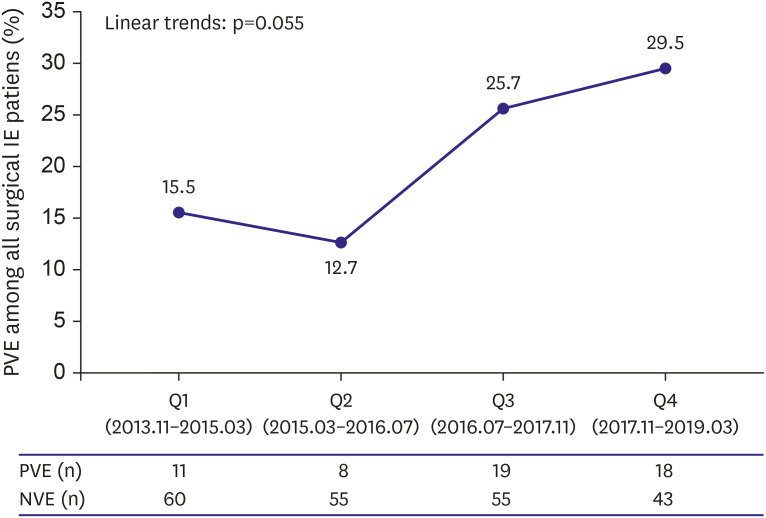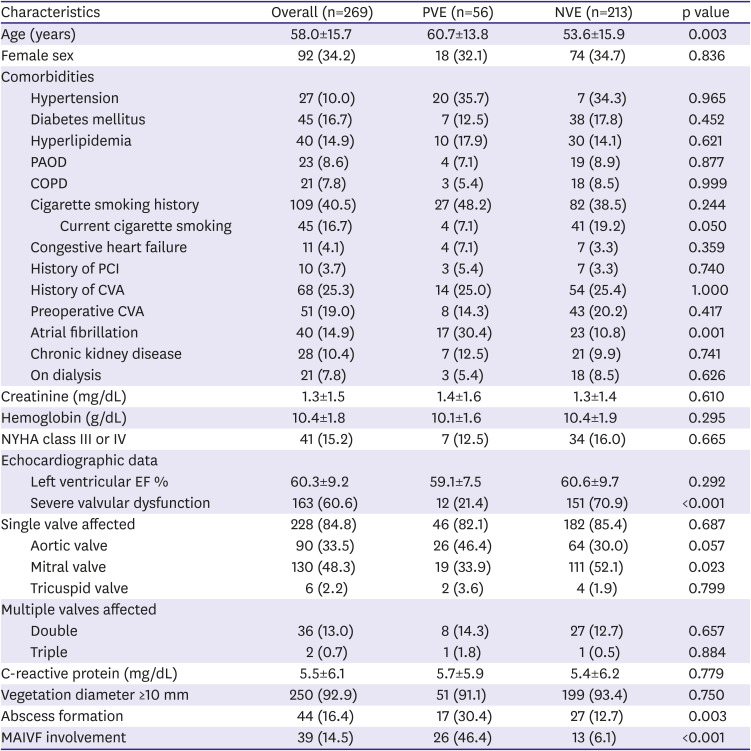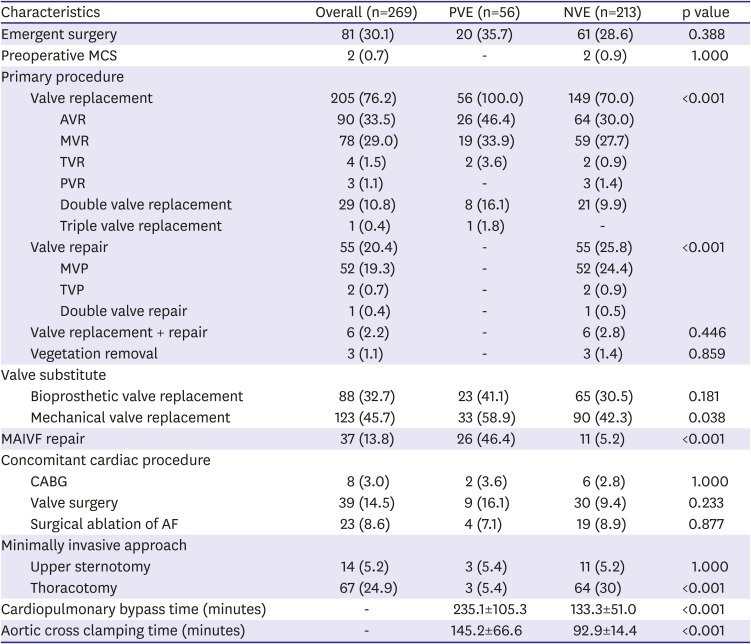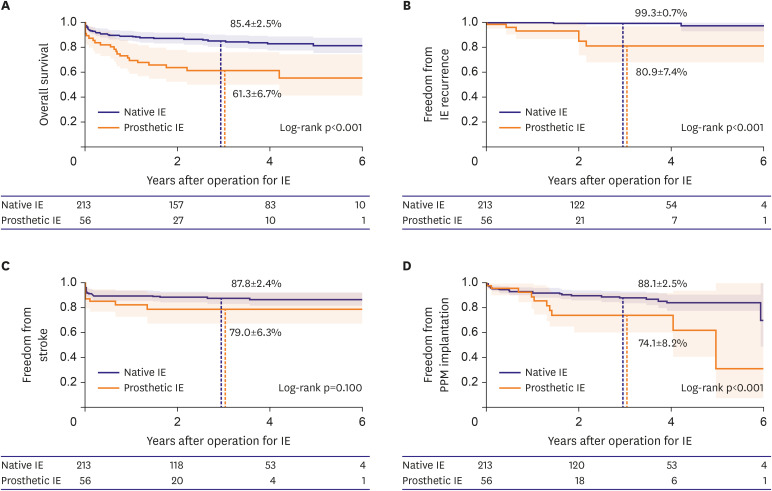1. Cahill TJ, Prendergast BD. Infective endocarditis. Lancet. 2016; 387:882–893. PMID:
26341945.

2. Perrotta S, Jeppsson A, Fröjd V, Svensson G. Surgical treatment of aortic prosthetic valve endocarditis: a 20-year single-center experience. Ann Thorac Surg. 2016; 101:1426–1432. PMID:
26453420.

3. Moreillon P, Que YA. Infective endocarditis. Lancet. 2004; 363:139–149. PMID:
14726169.

4. Romano G, Carozza A, Della Corte A, et al. Native versus primary prosthetic valve endocarditis: comparison of clinical features and long-term outcome in 353 patients. J Heart Valve Dis. 2004; 13:200–208. PMID:
15086258.
5. Akins CW, Miller DC, Turina MI, et al. Guidelines for reporting mortality and morbidity after cardiac valve interventions. Ann Thorac Surg. 2008; 85:1490–1495. PMID:
18355567.

6. Pettersson GB, Hussain ST. Current AATS guidelines on surgical treatment of infective endocarditis. Ann Cardiothorac Surg. 2019; 8:630–644. PMID:
31832353.

7. Habib G, Lancellotti P, Antunes MJ, et al. 2015 ESC guidelines for the management of infective endocarditis: the task force for the management of infective endocarditis of the European Society of Cardiology (ESC). Endorsed by: European Association for Cardio-Thoracic Surgery (EACTS), the European Association of Nuclear Medicine (EANM). Eur Heart J. 2015; 36:3075–3128. PMID:
26320109.
8. Tae BS, Jeon BJ, Choi H, Cheon J, Park JY, Bae JH. α-blocker and risk of dementia in patients with benign prostatic hyperplasia: a nationwide population based study using the National Health Insurance Service Database. J Urol. 2019; 202:362–368. PMID:
30840545.

9. Song SO, Jung CH, Song YD, et al. Background and data configuration process of a nationwide population-based study using the Korean National Health Insurance System. Diabetes Metab J. 2014; 38:395–403. PMID:
25349827.

10. Tornos P, Iung B, Permanyer-Miralda G, et al. Infective endocarditis in Europe: lessons from the Euro heart survey. Heart. 2005; 91:571–575. PMID:
15831635.

11. Mansur AJ, Dal Bó CM, Fukushima JT, Issa VS, Grinberg M, Pomerantzeff PM. Relapses, recurrences, valve replacements, and mortality during the long-term follow-up after infective endocarditis. Am Heart J. 2001; 141:78–86. PMID:
11136490.

12. Iung B, Duval X. Infective endocarditis: innovations in the management of an old disease. Nat Rev Cardiol. 2019; 16:623–635. PMID:
31175343.

13. Manne MB, Shrestha NK, Lytle BW, et al. Outcomes after surgical treatment of native and prosthetic valve infective endocarditis. Ann Thorac Surg. 2012; 93:489–493. PMID:
22206953.

14. Weber C, Petrov G, Luehr M, et al. Surgical results for prosthetic versus native valve endocarditis: a multicenter analysis. J Thorac Cardiovasc Surg. 2021; 161:609–619.e10. PMID:
31780064.

15. Edlin P, Westling K, Sartipy U. Long-term survival after operations for native and prosthetic valve endocarditis. Ann Thorac Surg. 2013; 95:1551–1556. PMID:
23562467.

16. Della Corte A, Di Mauro M, Actis Dato G, et al. Surgery for prosthetic valve endocarditis: a retrospective study of a national registry. Eur J Cardiothorac Surg. 2017; 52:105–111. PMID:
28329161.

17. Lalani T, Chu VH, Park LP, et al. In-hospital and 1-year mortality in patients undergoing early surgery for prosthetic valve endocarditis. JAMA Intern Med. 2013; 173:1495–1504. PMID:
23857547.

18. Pericart L, Fauchier L, Bourguignon T, et al. Long-term outcome and valve surgery for infective endocarditis in the systematic analysis of a community study. Ann Thorac Surg. 2016; 102:496–504. PMID:
27131900.

19. Murdoch DR, Corey GR, Hoen B, et al. Clinical presentation, etiology, and outcome of infective endocarditis in the 21st century: the International Collaboration on Endocarditis-Prospective Cohort Study. Arch Intern Med. 2009; 169:463–473. PMID:
19273776.
20. Musci M, Hübler M, Amiri A, et al. Surgical treatment for active infective prosthetic valve endocarditis: 22-year single-centre experience. Eur J Cardiothorac Surg. 2010; 38:528–538. PMID:
20547069.

21. Dohmen PM. Do we currently have guidelines to select an adequate prosthetic valve to surgically treat active infective endocarditis? Cardiol Ther. 2014; 3:73–76. PMID:
25135588.

22. Toyoda N, Itagaki S, Tannous H, Egorova NN, Chikwe J. Bioprosthetic versus mechanical valve replacement for infective endocarditis: focus on recurrence rates. Ann Thorac Surg. 2018; 106:99–106. PMID:
29452115.

23. AATS Surgical Treatment of Infective Endocarditis Consensus Guidelines Writing Committee Chairs. Pettersson GB, Coselli JS, et al. 2016 The American Association for Thoracic Surgery (AATS) consensus guidelines: Surgical treatment of infective endocarditis: Executive summary. J Thorac Cardiovasc Surg. 2017; 153:1241–1258.e29. PMID:
28365016.

24. Pettersson GB, Hussain ST, Shrestha NK, et al. Infective endocarditis: an atlas of disease progression for describing, staging, coding, and understanding the pathology. J Thorac Cardiovasc Surg. 2014; 147:1142–1149.e2. PMID:
24507402.

25. Graupner C, Vilacosta I, SanRomán J, et al. Periannular extension of infective endocarditis. J Am Coll Cardiol. 2002; 39:1204–1211. PMID:
11923047.

26. Wiggins NB, Chong DT, Houghtaling PL, et al. Incidence, indications, risk factors, and survival of patients undergoing cardiac implantable electronic device implantation after open heart surgery. Europace. 2017; 19:1335–1342. PMID:
27738074.

27. Hill TE, Kiehl EL, Shrestha NK, et al. Predictors of permanent pacemaker requirement after cardiac surgery for infective endocarditis. Eur Heart J Acute Cardiovasc Care. 2019; [Epub ahead of print].

28. Toyoda N, Itagaki S, Egorova NN, et al. Real-world outcomes of surgery for native mitral valve endocarditis. J Thorac Cardiovasc Surg. 2017; 154:1906–1912.e9. PMID:
28942975.

29. Harky A, Hof A, Garner M, Froghi S, Bashir M. Mitral valve repair or replacement in native valve endocarditis? Systematic review and meta-analysis. J Card Surg. 2018; 33:364–371. PMID:
29926515.













 PDF
PDF Citation
Citation Print
Print



 XML Download
XML Download